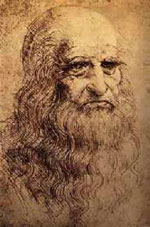

LEONARDO DA VINCI. 1452
- 1519
HERO AMONG HEROES
Leonardo's drawing of the inner workings of the human body are correct, accurate, meticulously observed down to the finest detail.
And yet, in one of his great drawings he shows a tube, going from the human heart straight to the tear ducts!
Human beings do not have a conduit from the heart to the tear ducts. Leonardo feels we should.
If you disagree
with the following italicised statement you may well be very scientific.
Something to be proud of. You may also be quite boring. Something to be
ashamed of. If you agree you may have a very deep soul. Something to be
proud of. You may also be a sentimental old fart. Something to be not
quite so proud of.
Consider it carefully:
The tear ducts going from the human heart straight to the tear ducts are TRUE.
Whether you agree or not is an excellent indicator of where you stand as regards the Two Cultures, the Sciences and the Humanities. It al depends how you interpret one of his great principles; the ability he valued as highly as any other: Saper vedere ("knowing how to see")
Drawing something
so cheeky and so right doesn't make Leonardo a great scientist. It might
not even in itself make him a great artist. Done by somebody else it could
be kitschy, or cute, or yukky, stupid, obvious, whimsical, fey, overdone,
cliched, ridiculous, a waste of time. All
of those charges would be accurate in a way.
It also happens to be a stroke of the purest genius.
This Science and
Art stuff is extremely fashionable now; and Leonardo is rightly one
of the greatest SciArt heroes, along with Goethe. But Leonardo
has never been out of the news; he was one of those lucky great men who
was famous even in his own lifetime. Exhibitions of his works are always
doing the rounds - although it has now been agreed that the Mona Lisa
has done enough travelling, what with one thing and another.
He died in 1519, and for a couple of hundred years his reputation rested
mainly on his unquestionably brilliant art, his paintings: the Mona Lisa,
The Last Supper and thirteen other works, not all of which were finished.
People also admired his treatise on painting.
He was a towering figure in art, and a hugely inventive one.
* He developed a marvellous technique for creating atmosphere in a
painting: it was called 'sfumato'.
* He virtually inaugurated the High Renaissance
* The Mona Lisa, and especially the Last Supper are not
just beautifully done, they are tremendously inventive; they are fiendishly
clever works.
